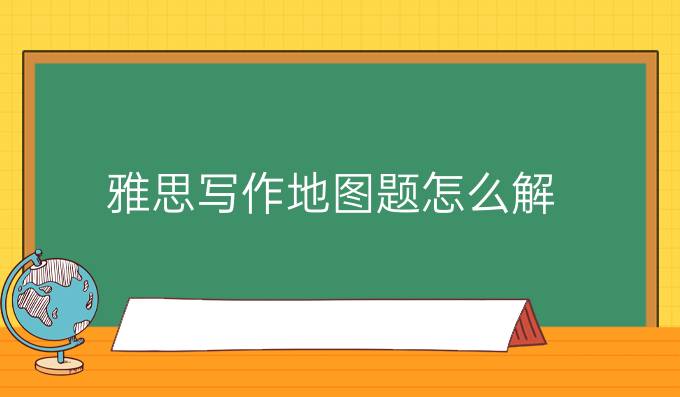对于雅思写作中的地图题,不少考生都闻风丧胆,原因有二:一是不知道从哪儿下笔写,导致主体段中的信息点和信息点没有衔接,读起来很混乱;二是方位表达方式和句型不会,造成“心里知道要写什么但是写不出来”的问题。朗阁海外考试研究中心的*们将在本文就这两个问题详细解答如何写处一篇好的地图作文。
对于雅思写作中的地图题,不少考生都闻风丧胆,原因有二:一是不知道从哪儿下笔写,导致主体段中的信息点和信息点没有衔接,读起来很混乱;二是方位表达方式和句型不会,造成“心里知道要写什么但是写不出来”的问题。朗阁海外考试研究中心的老师们将在本文就这两个问题详细解答如何写处一篇好的地图作文。
一、审题
一般情况下,地图题多为两个至三个地图,一个图写一个主体段。按照“内螺旋”(即,顺时针顺序)依次描述地图上的信息。这种顺序的本质,是先写出该地图上所有的*位置(即,图中的中心位置、西北、西南、东南,及东北五个位置),然后依次写其余的相对位置。如图所示:

当然,如果地图上有指向标的话,按照指向标来写,如果没有的话,按照常识(即,“上北下南,左西右东”)来写。
二、表达
作文是由句子构成的,句子由句型和词汇短语构成。因此,接下来的主体段中将从“词汇”和“句型”这两个方面来讲解如何写出一篇合格的地图来。
(1)词汇:
①空间顺序表达方式:
A在B的东方/西方/南方/北方
A be/ lie(s)/ be located/ be situated/ be sited on/ to/ in the west/ east/ north/ south of B.
A在B东北100千米处。
A be/ lie(s)/ be located/ be situated/ be sited 100 kilometers to the northeast of B.
A在B附近。
A be/ lie(s)/ be located/ be situated/ be sited near/ beside/ close to/ next to/ adjacent to/ in the vicinity of/ in the proximity of B.
A在B对面。
A be/ lie(s)/ be located/ be situated/ be sited opposite B.
A be/ lie(s)/ be located/ be situated/ be sited on the opposite side of B.
A在B西部边缘上
A be/ lie(s)/ be located/ be situated/ be sited along/ on the western edge of B.
②表示变化的表达方式:
a.原来数量增多/减少:
The number of flowerbeds has risen/ grown/ increased/ decreased/ reduced/dropped by 67%/ doubled/ tripled/ quadrupled/ quintupled.
b.原来尺寸变大/变小:
The scale/ size of XX has been extended/ enlarged/ halved/ reduced by 75%.
c.原来有的事物现在没了:
The houses disappeared/ were removed.
d.原来没有的事物现在新增加了:
a newly-built flowerbed
A flowerbed be newly constructed.
A new flowerbed has been added to the park.
e.原来是A,被替换成了B:
A be transformed/turned over/ reconstructed/ changed/ redeveloped to B.
A be substituted/ replaced by B.
A becomes B.
(2)句型:
①三大句型:
一个人工湖位于公园的东北角。
正常语序:
A lake is located/ is sited/ is situated/ is/ lies in the northeastern corner of the park.
倒装句型:
In the northeastern corner of the park is located/ is sited/ is situated/ is/ lies a lake.
There be句型:
There is a lake in the northeastern corner of the park.
除了可以为考生*替换的句型,“三大句型”还有一个重要目的是起到句子和句子之间的衔接。例如:
A flowerbed is situated in the northern side of the lake. The lake lies in the northeastern corner of the park.
A flowerbed is situated in the northwestern corner of the park. In the northeastern corner of the park is located a lake.
也就是说,为了使前后两个句子衔接,可以把前面句子结尾的单词(或短语)同义改写一下放在后面的句子开头,以此实现句子前后衔接。
所以,如果说“三大句型”的目的是为了让句子和句子之间有衔接,那么“两种拉长句子手段”的目的则是——在一个句子中出现同一个事物的两种相对位置描述。这“两种拉长句子手段”分别是什么呢?
②两种拉长句子手段:
1 , 介词+which+(主、谓、宾/主、系、表完整的)句子.
2 , 介词短语
以“A在B的附近”为例。
A be located in the vicinity of B.
其中,我们暂且称连接A的介词“in”为介词①,连接B的介词“of”为介词②。即:
A be located in the vicinity of B.
介词① 介词②
那么,“两种拉长句子手段”中的第1种(1, 介词+which+(主、谓、宾/主、系、表完整的)句子.)中的介词为介词②,第2种(2 , 介词短语)中的介词为介词①。即:
1 , 介词+which+(主、谓、宾/主、系、表完整的)句子.
介词②
2 , 介词短语
介词①
例如
A lake is located in the northeastern corner of the park, of which a flowerbed is in the vicinity.
A lake is located in the northeastern corner of the park, in the vicinity of a flowerbed.
又如:
A be adjacent to B.
介词②
A lake is located in the northeastern corner of the park, to which a flowerbed is adjacent.
或者:
A be near B.
介词②
A lake is located in the northeastern corner of the park, near which there is a flowerbed.
总之,“两种拉长句子手段”的目的就是在一个句子中,*一个写作对象的两个相对位置描述,因此可以更精准定位该写作对象。
三、注意事项
因为雅思Task1写作要求是:
Summarize the information by selecting and reporting the main features and make comparisons where relevant.
总结主要信息,并且在相关的地方进行比较。
换言之,所有雅思小作文(包括地图题)都需要写图表或者图画上的信息,而不能出现主观细节。
综上所述,雅思写作中的地图题拿分难度不大,只要考生把握好审题、“三大句型”、“两种拉长句子手段”即可,朗阁海外考试研究中心的老师们预祝考生们都能成功屠雅!









